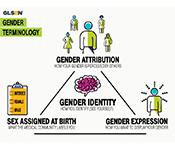LGBTQ 101: Terminology and Tips
The information below is intended to raise awareness and aid understanding of LGBTQ+ terminology and issues.
Each of these terms and definitions have been researched, analyzed and consulted upon based on perspectives, cultural sensitivity, common usage and appropriateness. Terminology, definitions and meaning for people change overtime, and this list should be merely a guide toward understanding and not the sole basis of acquiring the knowledge that encompasses a LGBTQ+ diverse community. Each person or community may have their own meanings and/or different terminology. We encourage you to ask first and do not let definitions to generalize an individual or population.
Jump to:
Gender Identities
There are a variety of gender identities besides those that fit within a gender binary. Here are a few common words to know:
- Transgender/Trans: A person who does not identify with the gender that they were assigned at birth.
- Genderqueer: A person who has a gender identity that falls outside of the norm for the gender they were assigned at birth.
- Nonbinary: Sometimes seen as "nb" or "enby." A person whose gender identity falls outside the gender binary.
- Genderfluid: A person who has a shifting or changing gender identity.
- Agender: A person who does not identify with gender.
- Androgyne: A person who desires a gender expression between binary gender expression, or someone whose gender does not fit the man/woman binary.
- Bigender: A person who identifies as two or more genders, whether simultaneously or in turn.
- Cisgender/Cis: A person who identifies with the gender that they were assigned at birth.
Sexualities
Understanding the prefixes below can help you more readily understand some sexual identities in the LGBTQ+ community. For more information, check out the other resources on this page.
| Prefix | Suffix | Definition |
|---|---|---|
| a- | romantic/sexual | Does not experience attraction toward anyone. |
| gray- | romantic/sexual | Rarely experiences attraction toward anyone. |
| demi- | romantic/sexual | Attracted to someone only after developing a very strong bond. |
| hetero- | romantic/sexual | Attracted to gender(s) other than their own. |
| homo- | romantic/sexual | Attracted to the same gender as their own. |
| bi- | romantic/sexual | Attracted to two or more genders. |
| pan- | romantic/sexual | Attracted to all genders/regardless of gender. |
| poly- | romantic/sexual | Attracted to multiple (but not necessarily all) genders. |
Traditional pronouns
The table below can help you understand more traditional pronouns and how to use them in conversation.
| Pronoun family |
Nominative (subject) |
Objective (object) |
Possessive determiner |
Possessive pronoun |
Reflexive |
|---|---|---|---|---|---|
| He | He smiled | I saw him | His eyes | That is his | He like himself |
| She | She smiled | I saw her | Her eyes | That is hers | She likes herself |
| They | They smiled | I saw them | Their eyes | That is theirs | They like themselves |
Neo-pronouns
The table below can help you understand newer pronouns and how to use them in conversation.
| Pronoun family |
Nominative (subject) |
Objective (object) |
Possessive determiner |
Possessive pronoun |
Reflexive |
|---|---|---|---|---|---|
| Ne | Ne smiled | I saw nem | Nir eyes | That is nirs | Ne likes nemself |
| Ve | Ve smiled | I saw ver | Vis eyes | That is vis | Ve likes verself |
| Spivak* | Ey smiled | I saw em | Eir eyes | That is eirs | Ey likes emself |
| Ze/zie/hir | Ze smiled | I saw hir | Hir eyes | That is hirs | Ze likes hirself |
| Ze/zie/zir | Ze smiled | I saw zir | Zir eyes | That is zirs | Ze likes zirself |
| Xe | Xe smiled | I saw xem | Xyr eyes | That is xyrs | Xe likes Xemself |
*Based on gender-neutral pronouns used by the mathematician Michael Spivak.
External Links
Explore the practical resources below to help broaden your understanding of the LGBTQ+ community. Please feel free to direct any questions to the Office of Diversity, Equity, and Inclusion.

The Gender Unicorn
An illustration of the differences between gender identity, gender expression/presentation, sex assigned at birth, sexual attraction and romantic/emotional attraction by Landyn Pan from Trans Student Education Resources (TSER). View high-resolution JPG.

GLSEN’s Gender Terminology Visual
Another illustration of the differences between sex assigned at birth, gender expression, gender identity, and gender attribution by GLSEN. View high-resolution PNG.
Glossary of Lesbian/Gay/Bisexual/Queer Terminology
An expanded glossary of LGBQ terminology, complete with terms to avoid, preferred terminology and more from GLAAD.
Glossary of Transgender Terminology
An expanded glossary of transgender terminology, complete with terms to avoid, preferred terminology and more from GLAAD.
Guide to Being an Ally to Transgender People
An guide (PDF) on how to be a strong ally to the transgender community from the National Center for Transgender Equality.
Tips for Supporting Non-Binary People
A quick tip sheet for understanding, respecting and supporting the non-binary community from the National Center for Transgender Equality.